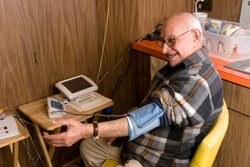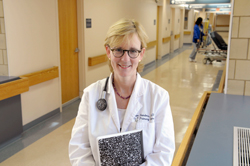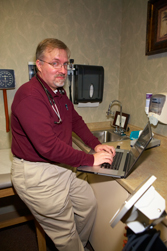Guidelines call for depression screening
Guidelines call for internists to screen for depression, but only if they can offer support once they make a diagnosis. Internists who've already achieved this describe how they did so, and how it's benefited their patients.
Most internists recall patients with vague complaints such as trouble sleeping, intermittent joint aches and fatigue. The exam and subsequent bloodwork yield nothing, yet when the internist delivers the news, the patient appears reluctant to leave.
The internist wonders if the patient is depressed, but fears that broaching the subject might put him or her not only further behind, but also in the position of leaving the patient in limbo if an expedient referral can't be arranged.

“When you start a conversation about psychosocial issues, it's really hard to wrap that up quickly,” said P.J. Helmuth, MD, an internist and pediatrician with Valley Medical Associates in Springfield, Mass. “And once you make the diagnosis, getting the resources can be very difficult. That's something people don't consider much in primary care physicians' reticence to screen for mental health problems: What am I going to do when I find them?”
New guidelines recommend that practices consider a staff-supported model, leaving internists, especially those who admit they're not doing a stellar job with depression, wondering if such arrangements are feasible and what they might entail.
The U.S. Preventive Services Task Force's (USPSTF) depression screening guidelines, published in the Dec. 1, 2009 Annals of Internal Medicine, call for the following in nonpregnant adults:
- Screen all adults for depression when staff-assisted care supports are in place to allow for accurate diagnosis, appropriate treatment and close follow-up. (The optimal screening interval is unknown.)
- Don't screen routinely if supports are not in place.
- Use any of several effective standard screening measures, including short two-question measures; choose a tool based on preference and practice characteristics.
- Keep in mind that patients with chronic medical conditions and those who are unemployed or of lower socioeconomic status are at higher risk for depression.
The USPSTF's rationale is threefold: About 20% of depression is missed in the primary care setting, yet primary care doctors deliver two-thirds of the depression care that patients receive. (In a typical 2,000-patient panel, between 6% and 10% of patients have major depression.) In addition, a growing body of research indicates that depression is comorbid up to half of the time in patients with diseases that internists commonly see and treat—heart disease, diabetes and inflammatory disorders. Treating that depression, studies have shown, can and does significantly improve chronic-disease outcomes.
For example, major depression after myocardial infarction (MI) is both common and a major risk factor for subsequent cardiac events, with those patients who were depressed at the time of initial MI showing increased mortality at 6 months, 18 months, and 5 years of follow-up.
“Internists are already seeing these patients, so screening for and treating [comorbid] depression may actually improve their overall care” said Jay Pomerantz, MD, an assistant clinical professor of psychiatry at Harvard Medical School.
Dr. Pomerantz has developed an algorithm that incorporates both screening and acute-phase management of depression tailored to primary care clinicians; it addresses treatment options, pharmacotherapy and recommended follow-up. acpi-201003-depression.pdf
Screening isn't enough
Ensuring a care continuum is hugely important in depression, according to Wayne Katon, MD, a professor of psychiatry at the University of Washington in Seattle whose research and clinical work have long focused on diagnosis and treatment of mental health disorders in primary care.
“There's a lot of evidence that if PCPs just screen for depression, there's little change in care quality and no change in outcomes,” said Dr. Katon, who added that underrecognition or lack of accurate diagnosis in most studies is as high as 40% to 50%, higher than the USPSTF figures.
“On the other hand, more than 35 trials have shown that if you screen and develop a team approach that includes a depression care manager helping the PCP with education, close follow-up, symptom tracking and treatment adherence—and getting patients back to the doctor if and when they're not doing well—outcomes dramatically improve. Some studies have shown an almost twofold improvement.”
That evidence prompted physician-hospital organization Baycare Health Partners in Springfield, Mass., whose network includes Dr. Helmuth's group, to beef up screening, starting with patients with chronic diseases such as diabetes, heart disease and inflammatory diseases, said nephrologist Michael O’Shea, FACP, Baycare's medical director.
In 2006, Baycare started screening for depression in diabetes patients, after discovering that depression in this group was under-recognized and under-treated based on scores in state quality-improvement initiatives.
“Our scores were abysmal, and we started with diabetes because we knew that 30% of those patients have depression,” Dr. O’Shea recalled. That initiative, though only moderately successful, spawned the other efforts.
Valley Medical Associates, part of Baycare Health Partners, will launch a new asthma pilot this month, funded in part by the National Institutes of Health. VMA will conduct online screening to identify comorbid depression or anxiety. Patients with positive scores will be treated and followed closely.
‘Staff-assisted’ care
Frederick Kelsey, FACP, and colleagues at Mid-State Health Center in Plymouth, N.H., put a depression screening system in place four years ago, after the primary care practice realized that patients with undiagnosed depression weren't recovering from their initially reported symptoms and returning for further treatment. “The patient has a need. That's your window of opportunity for effectiveness. Not two weeks from then, but right then,” said Dr. Kelsey.
The practice linked up with a group of clinical psychologists to provide depression screening, diagnosis and treatment at the point of care. They eventually merged the two entities, co-located the practices, and brought in a social worker.
“Life in the primary care trenches is tough enough, but to add screening and not be able to address the newfound problem only increases [internists'] sense of feeling overwhelmed and not meeting the patients' needs. Having the robust psych backup has unlocked that block,” Dr. Kelsey said.
Today, all patients at the center are screened for depression initially and at least annually thereafter. The screening, with the Patient Health Questionnaire Short Form (PHQ-2), is conducted by support staff as part of taking vital signs. The score is entered immediately into the electronic medical record (EMR). If the score suggests possible depression, the staff member may probe for details or, if the patient appears distressed, bring in the psychologist even before a physician sees the patient.
Giving support staff the “power to act on their recognition,” Dr. Kelsey added, has improved their job satisfaction because “they're more part of the team.” Staff also play an active role with the psychologists in following and monitoring patients with depression. In another unusual arrangement, the psychologists provide shorter therapy sessions—30 minutes rather than the more typical hour—and employ a tightly focused, problem-centered approach.
Somewhat unexpectedly, the physicians' co-location with psychologists, who bill as independent providers, has proved immensely valuable in increasing each group's knowledge and skills.
“The accuracy [in recognizing depression and other disorders] has vastly improved because we have learned from the psychologists. In the old days we would just label patients as either depressed or anxious,” Dr. Kelsey said. “Now we're much more tuned in to bipolar disease or post-traumatic stress disorder—things that are more ‘second-generation’ mental health issues. It took about a year to develop a common language, but it was very powerful in improving diagnostic accuracy.”
He cited the example of a patient who came in because she couldn't sleep, who under the previous model might have been given sleeping pills and asked to come back if she didn't improve. But an astute staff member sensed something was up and brought the psychologist into the loop. It turned out that the patient, who worked in a store, had been dragged outside and physically threatened by drunk customers, and was suffering post-traumatic stress.
“No medications were needed, and she was back on her feet after four sessions with the psychologist,” Dr. Kelsey said. “That wouldn't happen in a more traditional practice.”
Although the practice hasn't formally tracked patient outcomes in depression, anecdotally, physicians report that patients “get better quicker,” he added. “It's pretty cool. There's no downside.”
Dr. Kelsey acknowledged that a model like Mid-State's probably requires at least four primary care doctors—his group has two internists, four family physicians and one pediatrician—and enough support staff to handle scheduling, tracking and billing for additional patients. He added that reallocating roles and responsibilities within the practice was no small feat.
Systematic follow-up a must
USPSTF's new recommendations don't tell internists how to organize staff-assisted depression care, but they offer basic guidance based on the evidence of different models' effectiveness.
Staff support would include a nurse who screens patients, alerts the physician if depression is suspected and organizes the referral to behavioral treatment. At the other end of the spectrum, comprehensive collaborative-care models include:
- routine screening,
- clinician and staff training on depression recognition and its treatments,
- provision of or expedient referral to behavioral health services and
- close follow-up and supported self-care by nurse specialists.
The task force recommends against routine screening unless supports are available to ensure follow-up at recommended intervals, to determine not only how patients are feeling but also if they're following treatment. For example, adherence to antidepressants is a major issue, Dr. Pomerantz said. Some patients stop taking medications because of side effects, and needed dose or medication changes might not occur without close follow-up. That can lead to actual (or perceived) treatment failure or an inability to know when patients with resistant depression should be transferred to a psychiatrist's care.
“Most patients with depression can be treated in primary care, but those with resistant depression or bipolar disorder are best treated by a psychiatrist,” Dr. Pomerantz said. Primary care practices might consider collaborating on depression screening to strengthen the referral network and possibly share care managers.
One major barrier is that practices don't have a means of recouping the costs of a depression care manager because such activities aren't reimbursed. Psychiatrist oversight of the depression care manager has not been traditionally paid for by health plans, either, Dr. Katon noted. Yet that model, having a care manager in the primary seat and a psychiatrist available to provide caseload supervision, works very well.
Minnesota is experimenting with a model in which several insurers have agreed to work together to reimburse for both the care manager and psychiatrist supervision of primary care patients with depression, Dr. Katon noted. Insurers have developed billing codes or are using bundled approaches to cover both services.
The full-services model, like Mid-State Health's, isn't one that small or even midsized internal medicine practices could readily create, said internist Ned Calonge, MD, MPH, chair of the USPSTF. But that shouldn't stop internists from improving depression screening, he said, which is likely to pay off in the long run.
“We know that depression is a huge issue and that it generates visits for physical complaints,” he said. “Internists should be comfortable screening for depression, and could have their patients fill out the questionnaire in the waiting room. And then if they want to refer patients out for counseling, they'll have to identify those sources in their communities.”
Hitting roadblocks
That's where other roadblocks to good depression care often occur. Internist Elana Sydney, ACP Member, an assistant professor of clinical medicine at Jacobi Medical Center in the Bronx, who co-wrote the College's Physician's Information and Education Resource (PIER) module on depression with Steven R. Hahn, MD, acknowledged that even in academic centers referrals can be difficult. “We have a psychiatry clinic and a referral base, but there are times when the clinic is closed to new patients,” said Dr. Sydney.
David Shern, PhD, president and CEO of Mental Health America in Alexandria, Va., said that a disjointed health system stymies efforts to improve depression care.
“Systems such as Geisinger Health System and the Mayo Clinic will emerge as the models for collaborative care, but most practices don't have access to those resources,” Dr. Shern said. He suggested that small practices approach local medical societies or hospitals to aggregate community resources, and create more “demand-side” pressure on payers to increase resources and access to behavioral health therapists.
Dr. Sydney and other physicians agreed that screening is doable, can be handled by practice support staff, and needn't be terribly time-consuming. The PHQ-2, which takes about one minute, is a starting point, with the PHQ-9 (the longer version) as a second step if the PHQ-2 is positive. Most instruments, even longer ones such as the Zung Self-Depression Scale and the Beck Depression Inventory, can be completed in less than 10 minutes, ideally in the waiting room or assisted by a nurse or medical assistant.
Sandeep Vijan, ACP Member, a physician and investigator at the Ann Arbor VA Health System who has long studied and treated depression, offered a balanced view. Depression screening is likely to be effective where depression treatment is effective, he said, adding that screening tools' accuracy for picking up depression ranges from 66% to more than 95%.
“I wish screening was simple, but it isn't,” Dr. Vijan said. “The treatment has to be appropriate and those patients require a lot of follow-up in the first month or two—and that's not always easy in primary care.”





